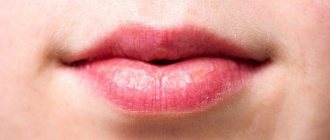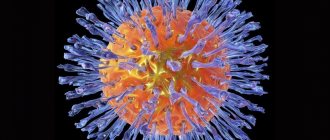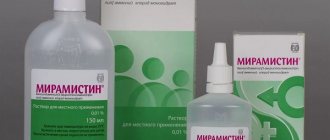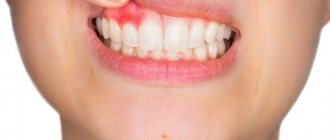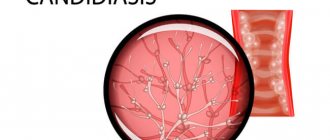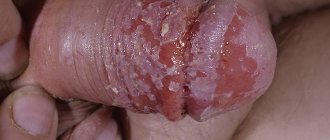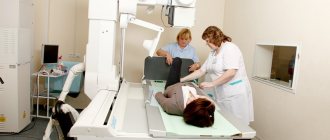Atopic
This disease is one of the symptomatic manifestations of atopic dermatitis. Characteristic signs are redness, slight swelling, itching, peeling of the skin in the red border area, as well as the spread of the inflammatory process to the corners of the lips, where cracks often form.
The cause is considered to be genetic abnormalities and poor heredity. By puberty, atopic cheilitis can heal itself or go into remission, but recurrent seasonal lesions cannot be ruled out. Allergens can be food, cosmetics, medications and many other factors.
Prevention of cheilitis
If you would like to avoid such a problem as cheilitis on the lips, never forget about basic preventive measures:
- visit your dentist and therapist for a preventive examination at least 2 times a year;
- Get tested periodically to monitor your health;
- Maintain oral hygiene regularly;
- for excessive dryness of the skin of the lips, use ointments and special hygienic lipsticks several times a day (after meals and also before bedtime);
- use softening lip masks several times a day;
- take vitamins and watch your diet (with a lack of vitamins, some forms of cheilitis can develop);
- If any damage to the skin or mucous membranes of the lips is detected, consult a doctor,
- temporarily avoid consuming acidic foods and drinks, as well as other ingredients that may irritate damaged areas of the skin;
- treat erosions and ulcers in a timely manner when they are first identified, but always consult a doctor before using any anti-cheilitis ointment, medication or paste.
Glandular
The main difference between glandular cheilitis is the presence of small red dots (enlarged hypertrophied salivary glands) on the red border of the lips. Droplets of salivary fluid are constantly released from these channels, which irritate the skin and provoke an inflammatory process, as well as drying out of the epithelium, the formation of cracks and erosions.
The disease itself appears as a result of gene abnormalities, or against the background of serious diseases. Treatment with drugs rarely gives a positive result, so most often the hypertrophied glands are removed surgically.
What causes cheilitis on the lips?
Being a benign inflammatory disease, cheilitis can occur under the influence of certain provoking factors:
- penetration of infection into wounds , microcracks and other types of open damage to the skin of the lips;
- adverse effects of the environment on the face and skin of the lips (wind, snow, sun, temperature changes, frequent contact with chlorinated water, etc.);
- regular use of lipstick and other low-quality decorative or skincare cosmetics containing harmful substances;
- frequent consumption of drinks with a high level of acidity , which can irritate the skin of the lips;
- an individual tendency to hypersensitivity of the skin of the lips or an individual allergic reaction to certain irritating agents (for example, fresh orange juice, honey, certain chemicals, etc.).
Symptoms of cheilitis
When diagnosing cheilitis, the doctor detects the affected areas of the red border of the lips. Lesions can manifest themselves in different forms and, in the absence of timely treatment, gradually move to other areas (the internal mucosa of the mouth and gums). Symptoms of cheilitis can have varying degrees of expression, but in all cases it is necessary to consult a doctor.
Features of the symptoms of this disease may differ, as they always depend on the etiology (origin) of cheilitis and its variety. Here only generalized symptoms and features of this disease will be named:
- redness of the entire surface of the skin and mucous membranes of the lips;
- loss of protection of the stratum corneum of the lips;
- the red border of the lips is usually visible only at their corners;
- loss of healthy color of the mucous membrane;
- wrinkles, cracks, wounds, ulcers on the lips;
- swelling of the lips;
- bleeding;
- peeling, itching, pain in the area where ulcers and cracks are located.
Classification of cheilitis and features of the manifestation of its varieties
Depending on the cause of the development of the disease, cheilitis is classified by doctors and divided into several main types:
| Type of cheilitis | Symptoms | Features and provoking factors |
| Grandular cheilitis |
|
|
| Actinic cheilitis |
|
|
| Allergic cheilitis |
|
|
| Exfoliative cheilitis |
|
|
| Atopic cheilitis |
|
|
| Candidal cheilitis |
|
|
| Eczematous cheilitis |
|
|
| Angular cheilitis |
|
|
To understand how to treat cheilitis, you need to determine the type of disease. But it is difficult to independently assess the degree and type based on symptoms, so it is better to refuse self-medication and trust a specialist. Treatment will depend on these factors.
Diagnosis of cheilitis
Due to the fact that cheilitis can be not only an independent disease, but also a sign of other ailments or pathological systemic disorders, the patient often has to consult different specialists (dentist, dermatologist, endocrinologist, venereologist, oncologist, therapist, etc.).
The patient may also be asked to undergo general tests, tests for hormones and identification of inflammatory and infectious diseases in the body.
Diagnostics is based on the following types of mandatory and optional tests:
- taking anamnesis;
- medical checkup;
- general tests;
- tests to determine hormonal status;
- ultrasound diagnostics;
- pathohistological examination of the salivary glands;
- dermatological scraping to determine infection in a laboratory setting.
How to treat cheilitis?
There are no universal treatment formulas for all diseases. When determining the treatment method, the doctor must rely on the diagnostic results, and also choose the method of therapy that is suitable for the patient according to individual indications.
Treatment of cheilitis will depend on many decisive factors:
- forms of the disease (acute or chronic),
- varieties (for example, atopic cheilitis),
- the reasons for its development (candida fungus, allergy to an irritating agent, etc.),
- degree of severity (mild symptoms, severe symptoms with progression of cheilitis and prolonged absence of treatment).
Let's consider the main methods of therapy for this disease (do not forget that before using one of them you should always first consult with specialists):
- Atopic cheilitis is treated first of all by eliminating the irritant; the doctor may also recommend dietary adjustments and antiallergic therapy, which will help suppress the symptoms with which cheilitis manifests itself. The ointment can also be an addition to general therapy.
- Grandular cheilitis is treated with anti-inflammatory drugs. For this type of cheilitis, ointments, electrocoagulation, and surgical procedures are often prescribed. Medicinal solutions will help avoid the spread of infection or fungi, so experts often recommend specialized rinses, as well as ointments and gels that are applied to the surface of the lips for cheilitis.
- Exfoliative cheilitis can be cured using methods of neuropathology and psychotherapy, hormonal therapy, radiation therapy, laser therapy. It is also recommended to regularly use a softening hygienic lipstick to eliminate signs of severe dryness of the red border of the lips. Often, the doctor prescribes medicinal rinses for the entire oral cavity.
- Actinic cheilitis , which usually develops after prolonged negative exposure to climatic factors (wind, solar ultraviolet radiation, cold and changes in external temperatures), is treated with special ointments with hormones. However, to protect your skin from ultraviolet radiation, it is recommended to use sunscreen or lip balm.
- Candidal cheilitis can be cured fairly quickly if you purchase an antifungal drug prescribed by a doctor. However, the therapeutic effect must be constantly maintained using special ointments such as clotrimazole, as well as daily rinses of the mouth using medicinal solutions. The fungus can reactivate at any time when the immune system weakens.
- Allergic cheilitis requires elimination of the irritant to which the patient has an allergic reaction. After this, you will need to undergo a course of treatment for cheilitis using antiallergic medications.
- Eczematous cheilitis should be treated using sedative and desensitizing drugs. At the same time, it is advisable to make some changes in your daily diet for a while.
Surgical treatment is used for cheilitis quite rarely. As a rule, the need for surgery arises only when serious complications of the disease appear. For example, with some of its varieties, a rough erosive crust forms on the surface of the skin of the lips, which is difficult to remove mechanically (and unsafe).
The doctor will help restore the mucous membrane of the lips, make the skin soft and elastic again, restore its healthy color and cure the disease. The operation may involve removing the crust that has formed, but the procedure can be quite painful and require some time for postoperative rehabilitation. After the operation, you will need to follow all the doctor’s instructions, make special compresses, apply medicinal ointments against complications of cheilitis, etc.
Eczematous
This type of cheilitis is a symptomatic manifestation of eczema, an inflammatory process on the surface layers of the epithelium caused by stress or allergic reactions. In the acute stage, eczematous cheilitis is accompanied by redness, burning, itching, swelling and pain in the lips. In addition, the acute course of the disease is often accompanied by the formation of vesicles, weeping blisters and crusts. When transitioning to the chronic form, swelling and hyperemia decrease, but infiltration increases, scales and nodules form. The main treatment for eczematous cheilitis is to take sedatives and antihistamines.
Allergic
Allergic cheilitis most often occurs in women after twenty years of age and is characterized by swelling, severe burning, itching and redness of the lips. Sometimes, with a severe allergic reaction, small blisters form on the skin, which burst, leaving behind cracks and erosions.
The reason is a tendency to allergic reactions and direct multiple contact with the allergen. Allergic contact dermatitis can be caused by any substance: lanolin from lipstick, components of toothpastes and dentures, paint from foreign objects, metal and anything that touches the lips. When allergic cheilitis occurs, treatment consists of identifying the allergen and eliminating it.
Herpetic
It is necessary to distinguish the manifestations of herpetic cheilitis from lip cancer. Despite the fact that in both diseases ulcerative lesions and dark brown crusts appear, the removal of which leads to bleeding, in the first case a striking distinctive feature is the formation of small blisters, after opening which erosions form. The appearance of blisters is accompanied by increased itching and burning in the area of inflammation. If left untreated, acute herpetic cheilitis can become chronic with frequent exacerbations.
Diagnostic features
If inflammation appears on the lip, it is advisable to visit a therapist, for children a pediatrician, if indicated, an infectious disease specialist, a dentist, or other specialized specialists. Diagnosing cheilitis is usually not difficult - a specialist will conduct an examination, listen to complaints and prescribe a series of tests. If the allergic nature of the disease is suspected, allergy tests may be recommended, and if plaque appears, it is advisable to take a scraping. To detect endocrine and other disorders that may cause the disease, biochemical blood tests and other diagnostic methods are often prescribed. In rare cases, a biopsy is required to differentiate cheilitis from other pathologies. This will help to exclude the malignant or precancerous nature of inflammatory formations and prescribe the correct treatment.
Chronic
The presence of chronic cheilitis in a patient indicates that at one time, due attention was not paid to the treatment of the acute form. The development of this form can also be caused by previous infectious diseases caused by yeast infections, streptococci and staphylococci, as well as injuries or hormonal imbalances.
Treatment of the chronic form of the disease is determined based on the cause of its formation. Types such as Miescher granulomatous cheilitis, streptococcal, glandular and meteorological cheilitis can become chronic.
